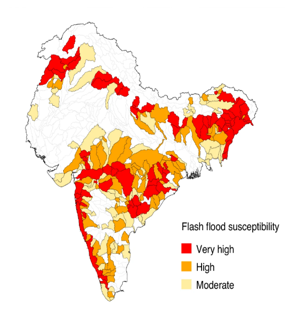

30th July 2025 (13 Topics)
Context
A recent study by researchers at IIT Gandhinagar, published in Nature, analysed flash flood patterns in the Indian subcontinent, identifying highly vulnerable river basins and key driving factors.
Flash Flood Hotspots:
- Most flash floods occur in the Himalayan, Central Indian, and West Coast regions.
- The Brahmaputra, Narmada-Tapi, Mahanadi, Godavari, Ganga, Mahi, Krishna, and Indus river basins have been identified as either “extremely prone” or “highly susceptible” to flash flooding.
Increase in Flash Flood Events:
- Flash flood events in India increased from 132 in 2002 to 184 in 2020 (as per official figures).
- Notable increases observed especially in the Brahmaputra basin, followed by Ganga and Krishna basins since 1995.
Driving Factors:
- Only 25% of flash floods are triggered solely by extreme precipitation.
- Remaining 75% result from compound effects:
- High antecedent soil moisture,
- Prolonged heavy rainfall,
- Rapid rainfall event after wet soil saturation.
Role of Climate Change:
- Between 1981–2020, rise in extreme rainfall frequency due to warming trends.
- Every 1°C increase in temperature raises moisture-holding capacity by 7%, causing more intense precipitation
Geomorphological Factors:
- Steep slopes and high relief in Himalayan and Western Ghats sub-basins contribute to faster runoff and flood onset.
- In central India, flashiness is driven more by rainfall concentration.
Adaptation and Mitigation:
- Calls for basin-specific strategies based on rainfall intensity, soil type, slope, and geomorphology.
- Importance of resilient infrastructure, early warning systems, and region-specific adaptation planning
More Articles



